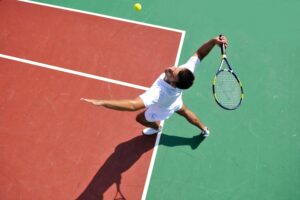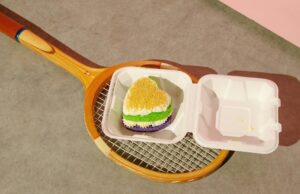Practice Makes Perfect – Serving Well When It Matters Most
The serve can make or break the entire outcome of a match. Just ask the former world No. 9, Brenda Schultz-McCarthy, who once held the record for the WTA’s fastest serve at 130 miles per hour.
According to Schultz-McCarthy, having a powerful serve allows the player to take control from the get-go of the match and dictate each point.

Brenda Schultz-McCarthy
From Throwing Baseballs to Powerful Serves
Before rising to the top of world rankings and developing one of the most infamous serves in the game, Schultz-McCarthy recalls throwing baseballs with her father. She was always trying to throw the ball farther than the day before. Years later, that innate competitiveness followed her to the court, where she would hit balls for hours on end to develop the power in her serve.
Before Every Powerful Serve, Comes the Perfect Toss
In order to effectively utilize the powerful serve to her advantage, Schultz-McCarthy devoted a significant amount of time perfecting the toss, an area she now works diligently on with her junior players. “When you need a big serve, the toss has to be in the right spot. I won a lot of matches where I came up with the big serve at the right time,” she explains.
The Key to Winning Is Learning How to Deal with The Pressure
Of course, having a powerful serve is not enough; players also have to learn to deal with the pressure that comes with focusing on the game-winning serve on the match points. Often, opponents will figure out how to counter the serve with their own style of play, and players must learn to adapt.
“You have to be smart, pay attention, and then change your game based what the opponent is doing to counteract you,” says Schultz-McCarthy. “Throw them off and don’t keep serving from the same spot if you’re losing. Move around the court to adapt.”
As a coach, Schultz-McCarthy urges players to go for their signature serve when the match is on the line, just as she did throughout her playing days. Even though her opponents knew her most deadly serves were on the deuce side down the T and on the ad side out wide, they rarely were able to return the ball because the serve was too powerful.
“In general, I tell my players to go for their weapon, which is where they feel most comfortable,” says Schultz-McCarthy. “But, if it is obvious that the opponent has no problem with their power, then they have to change the game plan and go for something that makes more sense.”
Practice, Practice, Practice
Most of all, Schultz-McCarthy emphasizes the value of good, old-fashioned repetition and practice for turning the serve into a weapon on the court. “Practice it a lot,” she urges. “Go out with a hopper of balls and practice. Figure out where your toss needs to be. Have someone film you from behind. Slow it down and show the players step-by-step what they’re doing with their toss. Once you know what you’re doing wrong, you can work on getting better.”
If Brenda Schultz-McCarthy’s career is any indication, perhaps practice truly does make perfect, or as close to perfect as it gets in tennis!








Comments: 0